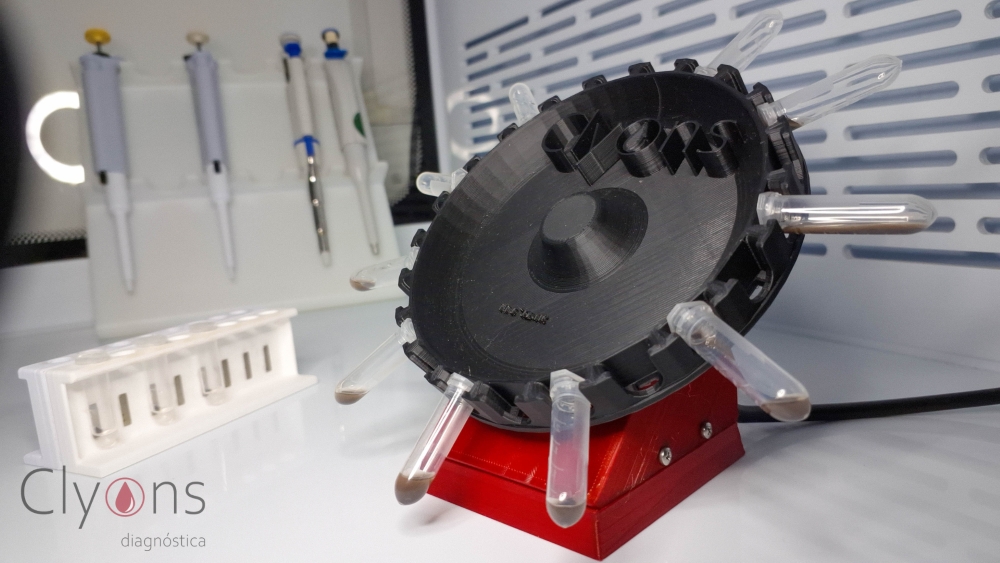


Image: Clyons
Published on 04/29/2024
By Roseli Andrion | Agência FAPESP – Having the capability of identifying micrometastasis can make a huge difference in treatment for cancer patients. In many cases, it can avoid invasive interventions and help maintain the quality of life.
A solution developed by the startup Clyons Diagnóstica can help achieve this aim in oral cancer patients. With support from FAPESP’s Innovative Research in Small Business Program (PIPE), the firm is developing a test to detect a biomolecule linked to the presence of oral squamous cell carcinoma micrometastasis. “We’ve successfully completed the proof of concept stage, and we’re already reaping some of the fruit,” said Thiago Prado, a chemist and co-founder of the startup.
The proof of concept used synthetic samples to simulate the presence of the biomolecule in living organisms. According to Prado, the current focus is a pilot test to establish a minimum viable product (MVP) for the hospital environment.
To this end, the firm has signed a cooperation agreement with the head and neck service at Hospital de Amor and Harena Inovação in Barretos, São Paulo state (Brazil). “We aim to achieve analytical and clinical validation in patient samples. This will involve head and neck surgeons and professionals from Hospital de Amor’s Department of Pathology as well as its Education and Research Center,” Prado said.
The validation process entails applying the methodology in a controlled environment, which in this case means patients treated at the cancer hospital in question. “Our goal will be to prove that the marker is present in the patients, a necessary step before any healthcare product can be commercialized,” Prado said.
The researchers are looking to protect their intellectual property rights to the technology and have begun drafting a patent application.
Relatively non-invasive
According to Prado, patients with floor-of-the-mouth cancer or neck cancer are often subjected to sentinel lymph node removal for biopsy or elective neck dissection to remove all neck lymph nodes. “In 70% to 80% of patients who undergo this process, no metastasis is found, and the individual could have been spared,” he said.
The procedure often causes functional and esthetic loss, frequently with irreparable damage to the patient’s quality of life, affecting the cervical lymphatic and muscular system. “It can also cause paralysis, loss of shoulder movement, voice and taste alterations, and difficulty swallowing, among other problems. In other words, its potential impact on patient well-being is considerable. Not to mention the expense,” he said.
Patients with early-stage tumors can choose not to undergo the procedure, but the disease may later be found to have progressed for lack of more thorough investigation. “In 20% to 30% of cases, micrometastasis goes undetected for a long time, and advanced cervical metastasis is eventually diagnosed,” he said.
The test proposed by Clyons is relatively non-invasive compared with surgical procedures, as well as being sensitive and accurate enough to be used in different stages of the disease. The researchers obtain a representative sample by lymph node puncture, a result that may not be possible when material is collected for anatomic pathology analysis, for example.
Early detection of micrometastasis can change conduct with regard to treatment. The technology is so promising, Prado explained, that the startup plans to adapt the biomolecule detection process to other types of cancer. “An example would be thyroid cancer or breast cancer,” he said.
Diagnostic aid
According to Prado, the technology developed by Clyons is as sensitive and accurate as others available on the market but involves fewer stages of sample processing and therefore saves time and money. “For disease diagnostic applications, it’s an incremental solution, providing one more piece of information to help reach a conclusion about the patient’s clinical condition,” he said.
The biomarker is captured as a solid and then released into a liquid medium for the detection process to take place. This entails biochemical reactions in a heterogeneous (solid/liquid) environment to arrive at pre-concentration of the biomolecule, increasing the sensitivity of the analytical method.
Public health
Oral cancer is a public health problem, Prado argued, especially for the SUS (Sistema Único de Saúde, Brazil’s networked national health service), because alcohol and tobacco are risk factors for the disease. “A large proportion of the Brazilian population are smokers and drinkers,” he said.
The period 2023-25 will see the emergence of 118,650 cases of head and neck cancer in Brazil, for an average of 39,550 per year, according to projections by the National Cancer Institute (INCA). The disease is one of the ten most prevalent cancer types in general. In men, oral cavity cancer is the fifth most common. In women, tracheal and thyroid cancer rank fourth and fifth respectively.
In the longer term, Clyons foresees the possibility of identifying biomolecules in peripheral blood by means of liquid biopsy. “That will help detect diseases systemically rather than just detecting metastatic foci,” Prado said.
He and his team expect to have an MVP in two years at most. “After that, there will have to be a few processes for transitioning the technology from research to development for the market. Regulatory approval is one example. We have no way of knowing how long that will take,” he said.
From the university to daily life
Clyons was founded in June 2022, with the primary aim of refining and applying the knowledge acquired by the researchers in their academic careers. “We began work on the head and neck cancer diagnostic project at the university, and we’re currently pursuing the same goal here at the startup. Our experience has always involved investigating biomolecules relating to this disease,” Prado explained.
The startup’s name links academic research with daily life, as a tribute to biochemist Leland Clark and microbiologist Champ Lyons, the scientists who invented the first biosensor in 1962. Their research led to the development of the first portable sensor for glucose in the blood. A device of this type is used on a daily basis worldwide by diabetics.
Source: https://agencia.fapesp.br/51533